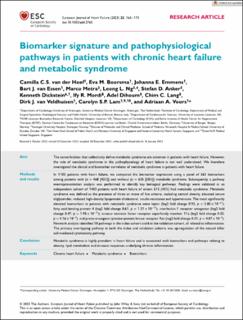Biomarker signature and pathophysiological pathways in patients with chronic heart failure and metabolic syndrome
van der Hoef, Camilla C.S.; Boorsma, Eva M.; Emmens, Johanna E.; van Essen, Bart J.; Metra, Marco; Ng, Leong L.; Anker, Stefan D.; Dickstein, Kenneth; Mordi, Ify R.; Dihoum, Adel; Lang, Chim C.; van Veldhuisen, Dirk J.; Lam, Carolyn S.P.; Voors, Adriaan A.
Journal article, Peer reviewed
Published version

Åpne
Permanent lenke
https://hdl.handle.net/11250/3089420Utgivelsesdato
2023Metadata
Vis full innførselSamlinger
- Department of Clinical Science [2318]
- Registrations from Cristin [9791]
Sammendrag
Aim
The comorbidities that collectively define metabolic syndrome are common in patients with heart failure. However, the role of metabolic syndrome in the pathophysiology of heart failure is not well understood. We therefore investigated the clinical and biomarker correlates of metabolic syndrome in patients with heart failure.
Methods and results
In 1103 patients with heart failure, we compared the biomarker expression using a panel of 363 biomarkers among patients with (n = 468 [42%]) and without (n = 635 [58%]) metabolic syndrome. Subsequently, a pathway overrepresentation analysis was performed to identify key biological pathways. Findings were validated in an independent cohort of 1433 patients with heart failure of whom 615 (43%) had metabolic syndrome. Metabolic syndrome was defined as the presence of three or more of five criteria, including central obesity, elevated serum triglycerides, reduced high-density lipoprotein cholesterol, insulin resistance and hypertension. The most significantly elevated biomarkers in patients with metabolic syndrome were leptin (log2 fold change 0.92, p = 5.85 × 10−21), fatty acid-binding protein 4 (log2 fold change 0.61, p = 1.21 × 10−11), interleukin-1 receptor antagonist (log2 fold change 0.47, p = 1.95 × 10−13), tumour necrosis factor receptor superfamily member 11a (log2 fold change 0.35, p = 4.16 × 10−9), and proto-oncogene tyrosine-protein kinase receptor Ret (log2 fold change 0.31, p = 4.87 × 10−9). Network analysis identified 10 pathways in the index cohort and 6 in the validation cohort, all related to inflammation. The primary overlapping pathway in both the index and validation cohorts was up-regulation of the natural killer cell-mediated cytotoxicity pathway.
Conclusion
Metabolic syndrome is highly prevalent in heart failure and is associated with biomarkers and pathways relating to obesity, lipid metabolism and immune responses underlying chronic inflammation.
